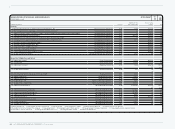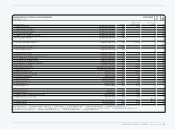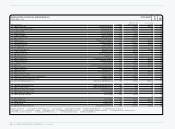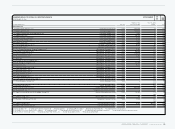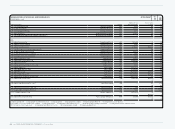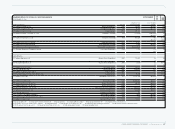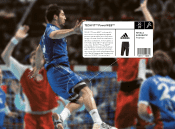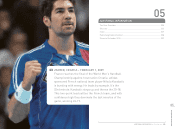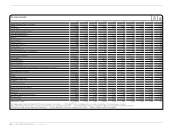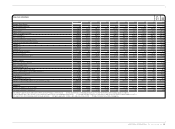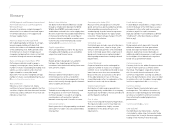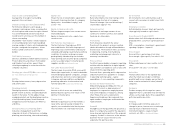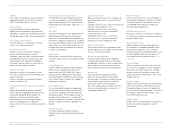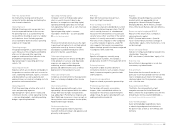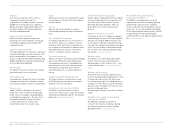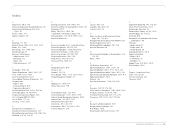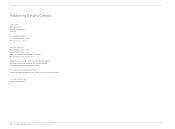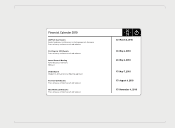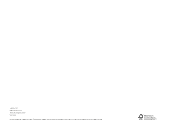Reebok 2009 Annual Report Download - page 226
Download and view the complete annual report
Please find page 226 of the 2009 Reebok annual report below. You can navigate through the pages in the report by either clicking on the pages listed below, or by using the keyword search tool below to find specific information within the annual report.
222 ADDITIONAL INFORMATION Glossary
Glossary
AFIRM (Apparel and Footwear International
Restricted Substances List Management
Working Group)
A centre of excellence comprising experts
whose aim it is to reduce the use and impact
of harmful substances in the apparel and
footwear supply chains.
American Depositary Receipt (ADR)
US-traded negotiable certificate of a foreign-
based company held by a US bank that
entitles the holder to all dividends and rights
of the underlying stock. ADRs provide a way
for Americans to invest in foreign-based
companies by buying their shares in the USA
instead of through an overseas exchange.
Basic earnings per share (Basic EPS)
Performance indicator used to gauge a
company’s earnings per share, based on the
number of shares outstanding (excluding stock
options, as well as options and conversion
rights related to a convertible bond).
Basic EPS = net income / weighted average
number of shares outstanding during the year
see also Diluted Earnings Per Share.
Beta coefficient
Indicates a stock’s relative risk. A beta
coefficient of more than one indicates that the
stock has a higher risk than the overall market.
Conversely, a beta coefficient of less than one
indicates a lower risk.
Better Cotton Initiative
The Better Cotton Initiative (BCI) was created
through a collaboration between the World
Wildlife Fund (WWF) and a wide range of
stakeholders involved in the cotton supply chain.
BCI aims to promote measurable improvements
in the key environmental and social impacts
of cotton cultivation worldwide to make it more
economically, environmentally and socially
sustainable see www.bettercotton.org.
Capital expenditure
Total cash expenditure used for the purchase
of tangible and intangible assets, excluding
acquisitions and finance leases.
Classics
Reebok products designed in an authentic
heritage style, targeting sports lifestyle
consumers who seek trend-setting street wear
with authentic origins.
Clearance sales
Revenues generated outside the course
of normal business terms, arising from
commercial decisions by management to clear
excess stock usually through specific channels
and at a significant discount.
Commercial paper
Tradable unsecured promissory notes issued
for the purpose of short-term financing.
Commercial paper is issued on an ongoing,
revolving basis with maturities typically
between seven days and 12 months or more.
Concession corners
Retail space that is fully operated by one brand
and is part of a larger sales area operated by a
retail partner.
Consumer price index (CPI)
Measure of the average price of consumer
goods and services purchased by households.
Determined by measuring the price of a
standard group of goods meant to represent
the typical market basket of a typical urban
consumer. The percentage change in the CPI
is a measure of inflation.
Controlled space
Controlled space includes own-retail business,
mono-branded stores, shop-in-shops, joint
ventures with retail partners and co-branded
stores. Controlled space offers a high level of
brand control and ensures optimal product
offering and presentation according to brand
requirements.
Convertible bond
Corporate bond that can be exchanged for
a specific number of shares of a company’s
common stock. Convertible bonds tend to have
lower interest rates than non-convertibles
because they also accrue value as the price
of the underlying stock rises. In this way,
convertible bonds reflect a combination of the
benefits of stocks and those of bonds.
Corporate governance
Distribution of rights and responsibilities
among the primary stakeholders in a company,
in particular shareholders, the Executive Board
and the Supervisory Board.
Cost of sales
Costs of sourcing and manufacturing products.
This figure includes costs for raw materials
plus costs of production, freight, customs
and delivery to the adidas Group’s sales
organisations.
Credit default swap
A credit default swap (CDS) is a swap contract
in which the buyer of the CDS makes a series
of payments to the seller and, in exchange,
receives a payoff if a credit instrument
(typically a bond or loan) undergoes a defined
“credit event”, often described as a default
(fails to pay).
Credit spread
Risk premium which represents the yield
difference between risk-free government
bonds and corporate bonds with the same
duration. A potential investor demands an
additional yield (risk premium = credit spread)
for the higher risk of default with corporate
bonds versus government bonds.
Currency exposure
Currency risks for the adidas Group are a direct
result of multi-currency cash flows within
the Group. The biggest single driver behind
this risk results from the mismatch of the
currencies required for sourcing our products
versus the denominations of our sales. In order
to minimise this risk, the adidas Group hedges
itself on a regular basis see also Hedging.
Currency-neutral
Financial figures translated at prior-year
exchange rates. This indicates increases or
decreases to reported figures by eliminating
variances arising from currency translation,
thus reflecting the underlying business
performance.
Currency option see Option
DAX-30 (DAX)
The DAX (Deutscher Aktienindex – German
stock index) is a blue chip stock market index
consisting of the 30 major German companies
trading on the Frankfurt Stock Exchange.


